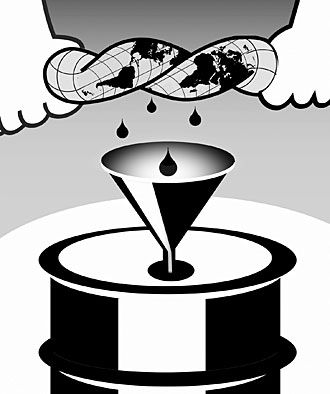Fracking
In the end, we're all downstream
Illustrator: Michael Duffy

My cousin works in the natural gas fields of the Bighorn Basin, just outside of Worland, Wyoming.
It’s a living wage job, one of the few nonprofessional positions available in the area, and much easier than the work as a ranch hand she had been piecing together. If she decides to have children, their education will be fully funded. According to Education Week, Wyoming annually spends on average $16,386 per student, the highest in the country. Thanks to the Hathaway Scholarship, funded since 2006 by federal mineral royalties, postsecondary study is virtually guaranteed to students willing to work hard and attend one of the state’s community colleges or the University of Wyoming, my own alma mater.
Natural gas is king in Wyoming. It fueled the $437 million budget surplus for fiscal year 2011, when enough was pumped out of the tens of thousands of acres of natural gas fields to fuel one in three homes in the United States. Groups such as the American Gas Association, the Natural Gas Supply Association, and America’s Natural Gas Alliance do their best to sell natural gas as an abundant, domestically available, and clean energy source. And most people seem to buy it. Maybe because they don’t see the actual impact of production. Or perhaps they choose not to see because of the short-term benefits it provides in places like in my home state.
Today, I live and teach in Portland, Oregon, but I still consider Wyoming home. My recent visits to Wyoming are like snapshots—before and after images—of the changes brought about by natural gas production since the 1990s: When I was a child, we went to Jackson’s slightly shabby main square to watch the stagecoach robbery re-enactment that was one of the highlights of the summer tourist season; now the shoot-out occurs in front of luxury stores.
Natural gas production in Wyoming is a lucrative and influential industry. All the perks—jobs, education spending, the budget surplus—are huge incentives for communities and the fossil fuel–friendly state legislature to play along, to stay silent. And many are willing. “The drilling is going to happen anyway,” I’ve heard people in Wyoming say, “so the state might as well get the benefits.”
There has been natural gas production in the state for almost a century, but gas, like all fossil fuels, is getting more difficult to find. As long as our country remains dependent on coal, oil, and gas, producers will utilize whichever techniques they can—including hydraulic fracturing—to meet the demand.
‘Gasland’
I showed the film Gasland to my 9th-grade global studies classes at Lincoln High School as part of a larger unit on global climate change. I wanted students to look critically at our current energy system, which relies almost exclusively on fossil fuels and to begin to explore lower carbon options—everything from specific alternative energy sources such as nuclear, wind, and solar power to market-based initiatives such as cap and trade, carbon offsets, and efficiency incentives. I wanted students to understand that every energy source has trade-offs. For example, harvesting the power of the sun has cloudy days, startup costs, storage issues, and, these days, the environmental impact of importing solar panels from China.
But I also wanted students to recognize that not all trade-offs are equal. Natural gas is a prime example, and Gasland was an engaging and shocking film for my students. Looking at hydraulic fracturing—“fracking”—was part of a broader exploration of what the energy industry is doing now that easy-to-find fossil fuels have run out. Fracking itself is a deadly serious issue, and the search for “extreme energy” also symbolizes our energy future as long as our country is wedded to fossil fuel.
Before viewing the film, we watched a video clip titled Facts About Natural Gas: the Natural Choice, produced by a regional gas company in the Midwest. (This video is no longer available online, but any number of natural gas ads would work.) As they viewed the video clip, I asked students to tease out the facts, according to the producers, and write them as statements. For example: “natural gas is abundant,” “natural gas is domestically available, ending our dependence on foreign sources of energy,” “natural gas is clean.”
Students appeared to take all of these claims at face value. We had just completed in-depth studies of oil and coal, and the general consensus seemed to be that “clean burning” natural gas had to be better than those.
“It makes you feel relieved,” wrote Duncan, “that there are ways to be clean, it uplifted everyone.” To my students, the message was clear and believable; after all, they’d seen many of the same kinds of ads from our local gas company, Northwest Natural: clean, safe, efficient, abundant.
“But how do we know these are facts?” I asked my students. “What more would you need to know to be certain of your answer? Add those questions to your list.” I wanted to draw my students’ attention to the claims (stated as facts) made by the natural gas producers about the benefits of natural gas, so they could figure out for themselves what they needed to know in order to evaluate those claims.
“While you watch Gasland,” I directed my students, “answer the questions listed on your paper. You may come up with more questions while you watch. We’ll take time to discuss the claims after the film is finished.”
The First Trade-Off: Money for Access
Gasland begins with a most basic trade-off, money for access. In 2006, Josh Fox, the filmmaker, was offered $100,000 for the rights to drill on his Pennsylvania family land, located on the Marcellus shale formation. This formation, “the Saudi Arabia of natural gas,” stretches from Virginia into Ohio, Pennsylvania, and New York. Money for privately held natural gas seems simple enough. But there is a catch, a more insidious trade-off that the natural gas producers would like people to ignore. In 2005, with the help of my fellow Wyomingite, then-Vice President Dick Cheney, a loophole was created in an energy bill that exempts the natural gas industry from many of the environmental regulations that could hamper gas production: the Clean Air Act, the Clean Water Act, and the Safe Drinking Water Act. Now the trade-offs get much more serious, and this is what Fox details in his film: What exactly are you in for if you—or your state—lease land for natural gas production?
The film follows Fox as he investigates the industry and its practices—specifically fracking. Fox begins with his neighbors and moves across the country.
Fox was a hit with my students: He was real enough, cool enough, and smart enough to take on fracking, a process that—using up to 2 million gallons of water and 80,000 pounds of “proprietary” (i.e., secret) chemicals per well, injects fluid into formations like the Marcellus, causing enough pressure and disruption of the earth’s crust to release the natural gas trapped in the rock. Over and over during the film, students turned to me and to each other with looks of disbelief. Thomas, normally my perpetual critic, was enraged, “Where does that stuff go?!” Minutes later he finds out: 70 percent of fracking fluid stays in the ground, even though 65 chemical compounds used in fracking are known to be hazardous to humans, and those are just the ones we know about.
Story after story in the film exposed the truth about natural gas production: contaminated water wells; fracking disruptions that knock volatile gases such as methane free, creating “flammable” water taps in people’s homes; the seeping of neurologically damaging fracking solvents into watersheds; toxic air pollution; mass deaths of fish and other water life in streams.
According to Fox:
Gas drilling and hydraulic fracturing is an inherently contaminating industrial process that injects millions of gallons of water, laced with toxic chemicals, at enormous pressure, to break apart rock and release gas from underground formations. Watersheds across the nation have been contaminated with plastics, carcinogens, neurotoxins and endocrine-disrupting chemicals—and with explosive natural gas. It causes massive land scarring, air pollution, a public health crisis, massive truck traffic, miles and miles of pipelines, blowouts, spills, accidents.
So, for example, Pinedale, close to the largest natural gas production site in Wyoming, spends more money on children than any other school district in the nation, plus providing bonus checks for teachers and new facilities. But it is often the most dangerous place in the country to breathe the air, and the drinking water puts everyone at risk. What good is it, asks Fox, if the children aren’t safe living there?
After we finished Gasland, students used their original facts/claims (from the natural gas ad), questions, and answers to write about natural gas and its trade-offs. Sydney summarized class opinion:
In the first commercial we watched, the company told us that natural gas is abundant, and judging by what I’ve seen in Gasland, that seems true. That’s probably the only part that was… The rest of the “facts” were created to lead the U.S. people into a false sense of security… I know that retrieving natural gas is not efficient, it is not clean, and it is definitely not safe.
This is not exactly in line with the public relations message of the gas industry, and the industry has attacked the film repeatedly. A Google search for Gasland leads to all sorts of industry PR videos and disclaimers. But this search also takes you to Fox’s website where he, along with environmental activists, educators, chemistry and biochemistry professors, an engineer, and a retired EPA official provide detailed information on “The Truth Behind Gasland”.
The film and these additional resources are so powerful because they are an antidote to the smoke, mirrors, and very real money behind the industry. And, despite the devil’s bargain the industry has pushed, all of Wyoming is not hoodwinked. There are wonderful environmental groups such as the Powder River Basin Resource Council, based in my hometown of Sheridan, which are actively trying to shape the energy and environmental future of the state. And anyone who lives downwind or downstream certainly knows what’s going on as they struggle to get clean water or stay healthy despite the impact of fracking.
But in the end we’re all downstream—and that was my purpose in showing this film. The health and environmental costs are too high, the trade-offs too costly, to see natural gas, or any fossil fuel, as a viable energy source. My students understood this. As Duncan said: “When we watched Gasland I believe everyone became scared and felt that there was no hope. But what is better? Knowing the real-life scary facts, or just to be ignorant and easily persuaded?” My students were now in a perfect place to begin to investigate alternatives—just where we need to be as a country.
Resources
Gasland. Directed by Josh Fox. Docurama, 2010. gaslandthemovie.com.

